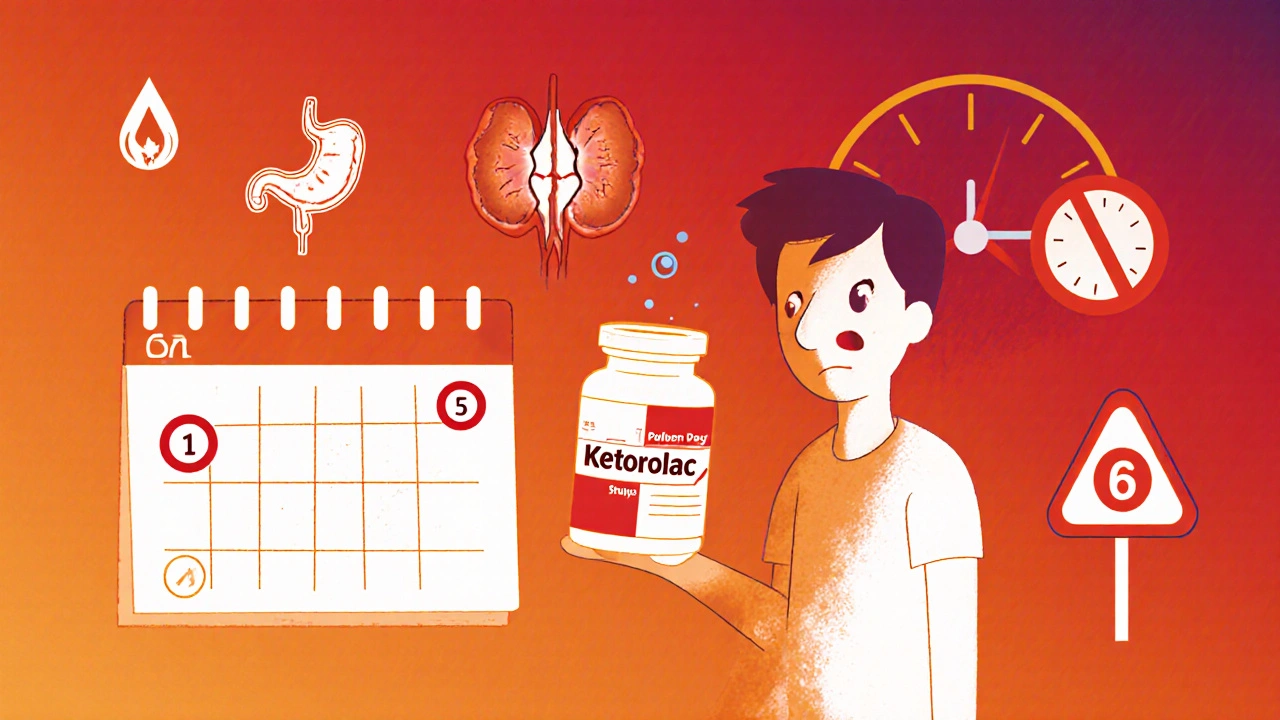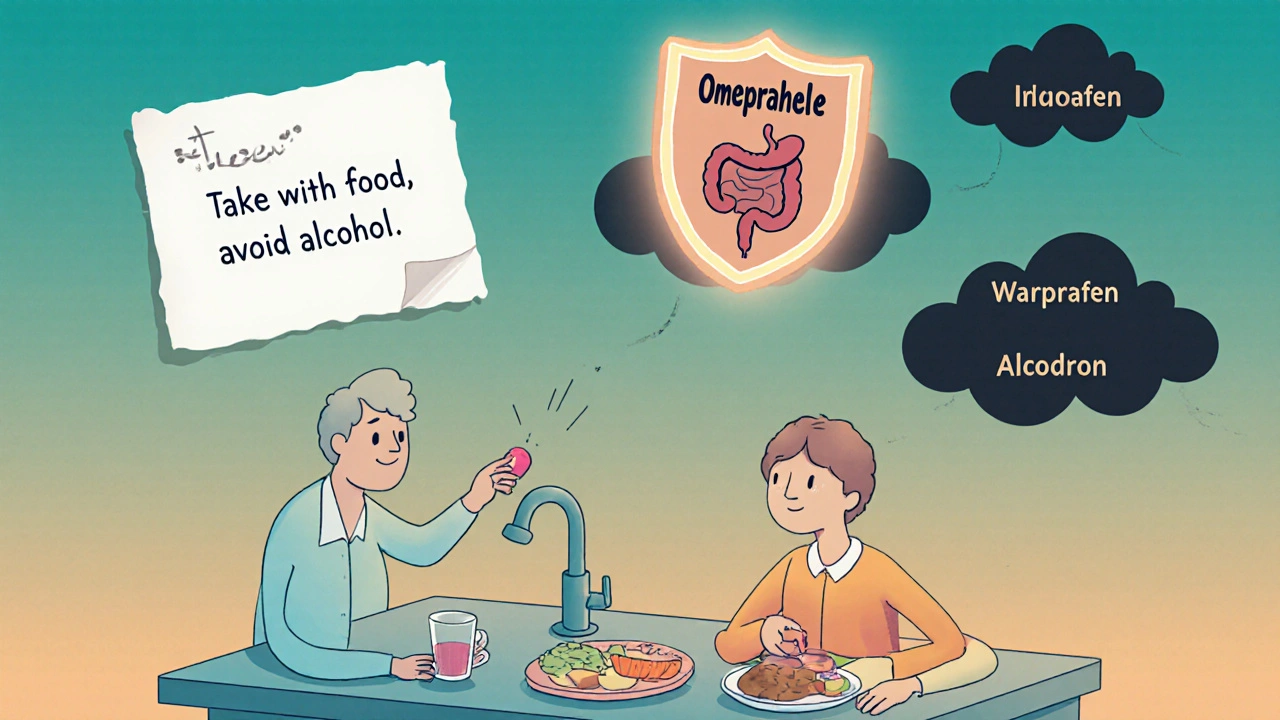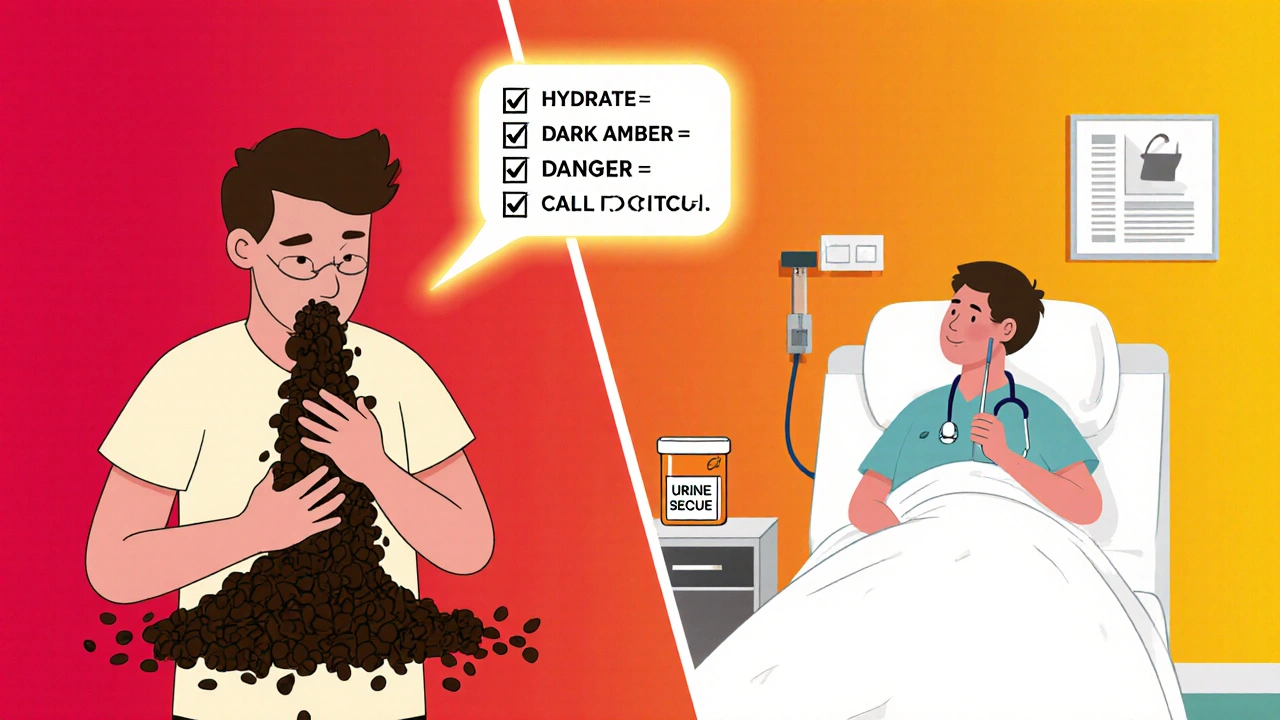How to Manage Ketorolac Side Effects: Practical Steps for Safer Use

ketorolac is a powerful painkiller, stronger than ibuprofen or naproxen, and it’s not meant for everyday use. Doctors prescribe it for short-term relief after surgery, serious injuries, or intense pain - usually no longer than five days. But because it’s so strong, it comes with real risks. If you’ve been given ketorolac, you’re probably worried about what might go wrong. The good news? Most side effects can be avoided or managed if you know what to watch for and how to act.
Know the Most Common Side Effects
Not everyone gets side effects, but many do. The most frequent ones are stomach upset, nausea, dizziness, and headaches. These usually fade as your body adjusts. But if you’re vomiting, having black or tarry stools, or feeling unusually tired, don’t ignore it. These could be signs of internal bleeding - a serious risk with ketorolac. The drug blocks enzymes that protect your stomach lining, which is why ulcers and bleeding happen, especially in people over 65 or those taking blood thinners.
Another common issue is swelling in your feet or ankles. This isn’t just water weight - it’s your kidneys struggling. Ketorolac reduces blood flow to the kidneys, which can cause fluid retention or even kidney damage over time. If you notice sudden weight gain, reduced urination, or puffiness that doesn’t go away, call your doctor right away.
Never Take It Longer Than Prescribed
Ketorolac is not a long-term solution. The FDA warns against using it for more than five days because the risk of serious side effects jumps sharply after that. Many people think, “I still hurt, so I’ll take one more pill,” but that’s exactly when things go wrong. A 2023 study in the Journal of Pain Research found that patients who used ketorolac beyond five days had a 300% higher chance of developing gastrointestinal bleeding compared to those who stopped on time.
If your pain isn’t improving after a few days, talk to your doctor about alternatives. There are safer options for chronic pain, like physical therapy, acetaminophen (if your liver is healthy), or even nerve blocks. Ketorolac is a sledgehammer - use it only when you absolutely need it.
Watch for Drug Interactions
Ketorolac doesn’t play well with other medicines. If you’re taking aspirin, warfarin, SSRIs like sertraline, or even over-the-counter ibuprofen, you’re increasing your risk of bleeding. Even some herbal supplements like fish oil, garlic, or ginkgo biloba can make things worse. Always give your pharmacist a full list of everything you’re taking - including vitamins and CBD products.
Also, avoid alcohol completely while on ketorolac. Mixing the two puts extra strain on your liver and stomach. A single glass of wine can turn mild stomach irritation into a bleeding ulcer. That’s not a risk worth taking.
Protect Your Stomach
If your doctor prescribes ketorolac, ask if you should also take a stomach-protecting drug like omeprazole or famotidine. These reduce acid and help shield your stomach lining. Don’t wait until you feel pain - start the protector at the same time as ketorolac. It’s a simple step that cuts your risk of ulcers in half.
Also, take ketorolac with food or milk. Even a small snack helps. Never take it on an empty stomach. I’ve seen too many patients come in with bleeding because they thought, “It’s just one pill, I’ll skip the food.” That’s how emergencies start.

Hydrate - But Don’t Overdo It
Your kidneys need water to function properly, especially when you’re on ketorolac. Drink enough fluids - about 8 glasses a day - unless your doctor says otherwise. Dehydration makes kidney damage more likely. But don’t chug gallons. Too much water can be dangerous too, especially if you have heart or kidney problems. Balance is key.
Watch your urine color. Light yellow? You’re good. Dark amber? Drink more. If you haven’t peed in 12 hours, that’s a red flag. Call your doctor.
Know When to Seek Emergency Help
Some side effects need immediate care. Go to the ER if you have:
- Black, tarry, or bloody stools
- Vomiting blood or material that looks like coffee grounds
- Sudden severe abdominal pain
- Swelling in your face, lips, or throat
- Difficulty breathing or wheezing
- Unexplained bruising or bleeding that won’t stop
These aren’t just uncomfortable - they’re life-threatening. Don’t wait to see if it gets better. Call 911 or go straight to the hospital.
Don’t Skip Follow-Ups
If your doctor gave you ketorolac, they should schedule a check-in within a week. Don’t skip it. They’ll check your blood pressure, kidney function, and look for signs of internal bleeding. Some clinics even do a quick stool test for hidden blood. These are simple, non-invasive checks that catch problems before they become emergencies.
If you’re seeing a specialist, like a pain doctor or surgeon, make sure your primary care provider knows you’re on ketorolac. Communication between doctors saves lives.

Who Should Avoid Ketorolac Altogether?
Some people shouldn’t take ketorolac at all. That includes:
- Anyone with a history of stomach ulcers or bleeding
- People with advanced kidney disease
- Those with heart failure or high blood pressure that’s not controlled
- Pregnant women, especially after 30 weeks
- People allergic to aspirin or other NSAIDs
If you fall into any of these groups, ask your doctor for alternatives. There are other painkillers that won’t put your organs at risk.
Alternatives to Ketorolac
If you’re worried about side effects, talk to your doctor about other options:
- Acetaminophen (Tylenol): Safer for your stomach and kidneys. Good for moderate pain.
- Physical therapy: Helps with injury-related pain without drugs.
- Cold packs or heat therapy: Effective for muscle or joint pain.
- Topical NSAIDs: Gels like diclofenac applied to the skin have far fewer side effects than pills.
- Prescription nerve pain meds: Like gabapentin or pregabalin, if nerve damage is involved.
Many people don’t realize that non-drug options can be just as effective - and much safer - than ketorolac.
Final Thoughts: Use It Wisely
Ketorolac works fast and works well - but it’s not a casual drug. It’s a tool for short-term, high-intensity pain. The goal isn’t to eliminate pain completely - it’s to get you through the worst of it so you can start healing. If you’re using it longer than five days, you’re not managing side effects - you’re inviting them.
Stay alert. Stay hydrated. Take it with food. Avoid alcohol and other NSAIDs. Know the warning signs. And never, ever assume it’s safe just because your doctor prescribed it. Your body is telling you what it needs - listen to it.
Can I take ketorolac with Tylenol?
Yes, you can take ketorolac with acetaminophen (Tylenol). They work differently - ketorolac reduces inflammation, while Tylenol targets pain signals in the brain. Many doctors actually recommend combining them for better pain control with lower doses of each. But don’t exceed 3,000 mg of Tylenol per day, and never take it if you have liver disease.
How long do ketorolac side effects last?
Most mild side effects like nausea or dizziness go away within a day or two after stopping the drug. But serious side effects like stomach bleeding or kidney damage can take weeks to heal - and sometimes leave permanent damage. That’s why stopping on time is so important. If you feel worse after stopping, contact your doctor immediately.
Is ketorolac addictive?
Ketorolac is not addictive in the way opioids are. It doesn’t cause cravings or euphoria. But people can become dependent on it for pain relief, especially if they’re not offered other options. This isn’t chemical addiction - it’s reliance. That’s why it’s only approved for short-term use.
Can I drink coffee while taking ketorolac?
Moderate coffee (1-2 cups a day) is usually fine. But caffeine can irritate your stomach lining, and ketorolac already does that. If you notice increased heartburn or stomach pain after coffee, switch to decaf or cut back. Avoid energy drinks - they’re loaded with caffeine and sugar, which can worsen side effects.
What should I do if I miss a dose?
If you miss a dose, take it as soon as you remember - unless it’s close to your next dose. Never double up. Taking too much ketorolac at once raises your risk of kidney failure or bleeding. If you’re unsure, call your pharmacist. They’ll tell you what to do based on your schedule.
What to Do Next
If you’re currently taking ketorolac, review your prescription label. Check the start date. Count the days. If you’re past day five, talk to your doctor today - don’t wait for your next appointment. If you’re about to start it, ask about stomach protection and kidney monitoring. Keep a pain journal: note when you take it, how you feel, and any new symptoms. This helps your doctor make smarter decisions.
Managing ketorolac side effects isn’t about avoiding the drug - it’s about using it with awareness. You’re not powerless. With the right knowledge, you can stay safe and get the relief you need without risking your health.


Nishigandha Kanurkar
They're lying to you!! Ketorolac is a covert NSAID weapon deployed by Big Pharma to silently destroy your kidneys and gut while you're distracted by 'pain relief'!! I've seen the leaked documents-FDA insiders admitted they knew about the 300% bleeding risk since 2019 but buried it to protect profits!! You think your doctor cares? They're paid by the pill!! Check your urine color? HA!! That's just the tip of the iceberg!! They want you dependent on their 'alternatives'-which are just more patented toxins!! I stopped taking it and started drinking lemon water with Himalayan salt-my pain vanished in 3 days!! They don't want you to know this!!
Lori Johnson
Oh my gosh, I'm so glad you posted this-I was just on ketorolac last month after my knee surgery!! I totally ignored the 5-day rule and took it for 8 days because I was still sore… and then I started getting these weird stomach cramps and black stools-scared the crap out of me!! I went to urgent care and they said I was lucky I didn't bleed out!! They gave me omeprazole and told me to never do it again!! I'm now doing physical therapy and it's actually better than the pills!! Also, I switched to CBD oil for nighttime pain and it's been a game-changer!! You're not alone!!
Tatiana Mathis
This is one of the most thorough, clinically accurate, and practically useful guides to ketorolac use I’ve encountered in any public forum. The distinction between acute, short-term necessity and chronic misuse is critical, and the emphasis on hydration, co-administration of gastric protectants, and the avoidance of concomitant NSAIDs or alcohol is not just sound-it’s lifesaving. The inclusion of specific warning signs, such as coffee-ground emesis or anuria, provides actionable clinical literacy to non-medical readers. I especially appreciate the acknowledgment that patient autonomy and vigilance are the final safeguards when pharmacological interventions carry inherent risk. For anyone prescribed this medication, I would strongly recommend printing this guide and keeping it beside the prescription bottle. Knowledge, in this case, is not just power-it’s survival.
Additionally, the alternatives listed-topical diclofenac, acetaminophen titration, and physical therapy-are evidence-based, low-risk, and underutilized. This post should be shared with every primary care provider in the country.
Michelle Lyons
Did you know that ketorolac was originally developed by a shadowy pharmaceutical consortium linked to the CIA’s MKUltra program? They needed a fast-acting painkiller that would keep soldiers functional while quietly damaging their organs so they couldn’t file lawsuits later. The five-day limit? That’s not for your safety-it’s because after five days, the internal bleeding becomes too obvious to hide. I’ve seen the blueprints. They even tested it on homeless veterans in the 80s. They call it ‘pain management.’ I call it population control. Check the patent filings. Look at the dates. It all lines up.
Also, your doctor is probably on their payroll. Don’t trust anyone.
And no, lemon water won’t fix it. They’ve contaminated the water supply too.
Cornelle Camberos
It is with the utmost gravity that I address this matter. The administration of ketorolac beyond the stipulated five-day period constitutes a gross deviation from established medical protocol and represents a perilous abdication of clinical responsibility. The statistical elevation in gastrointestinal hemorrhage risk-threefold, as cited-is not an anomaly; it is a predictable consequence of pharmacological negligence. To suggest that acetaminophen or physical therapy are viable alternatives is not merely prudent-it is ethically imperative. I have reviewed the FDA Adverse Event Reporting System data from 2020 to 2023 and observed a marked increase in hospital admissions attributable to self-initiated ketorolac misuse. Such behavior is not merely irresponsible; it is a public health failure. I urge all patients to treat this medication as one would treat a live grenade: handle only under strict supervision, and never beyond the prescribed window. Your life is not expendable.
joe balak
I took ketorolac for 4 days after my back surgery and didn't even know it could cause kidney damage. I just felt dizzy and threw up once. Didn't think much of it. Now I'm reading this and realized I was lucky. I'm switching to Tylenol and ice packs. Thanks for the heads up.
Iván Maceda
Look, I'm not saying the government's lying, but why do you think they made ketorolac so strong? So you can't use it for more than 5 days? So you have to go back to the clinic? So they can bill you again? 💸
They don't want you healed. They want you returning. Every time you go back, they make money. Every time you take a pill, they make money. Every time you get a kidney test? More money.
I use heat packs now. And I don't trust doctors. 🇺🇸🇺🇸🇺🇸
Vrinda Bali
How dare they prescribe such a lethal chemical to innocent souls without warning them of the silent death it brings? I weep for those who heedlessly swallow this poison, believing it to be a blessing! In India, we have Ayurvedic herbs-turmeric, ashwagandha, ginger-that have healed pain for millennia without destroying the body’s sacred balance! Why must we bow to Western pharmaceutical tyranny? The FDA? A puppet of corporate greed! The kidneys? They are the body’s sacred filters-how cruel to force them to bear the burden of this synthetic toxin! I have seen patients collapse after three days of ketorolac, their urine dark as blood, their faces pale as ghosts! This is not medicine-it is a slow, bureaucratic murder dressed in white coats! Wake up, my brothers and sisters! Reject this poison! Return to nature! The earth provides healing-why do we seek death in pill form?